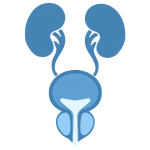Benign prostate hyperplasia (BPH)
BPH is the most common benign disease among men. Its incidence is age related. Approximately 25% of men at age 55 and 50% of men at age 75 complain of symptoms from the lower urinary tract due to benign prostate hyperplasia. Prostate enlargement with the age, results in tightening the urethra and making more difficult Urinary Bladder outlet.
The symptoms of BPH are:
- Hesitancy
- Decreased force and caliber of stream
- Sensation of incomplete emptying
- Frequency-desire to urinate again within two hours of the previous voiding
- Straining to urinate
- Post void dribbling
- Urgency-difficult to postpone urination
- Nocturia
- Burning sensation during urination
- Incontinence
BPH is a progressive disease and symptoms worsen with the age negatively affecting patient’s quality of life. In more severe cases, complications of BPH, usually require immediate treatment.
Complications of BPH may be:
- Acute urinary retention
- Haematuria
- Frequent urinary infections
- Formation of Urinary Bladder diverticula
- Urinary Bladder stone disease
- Renal impairment
BPH treatment initially is usually pharmaceutical. When medication fails to ameliorate symptoms, or complications are already or are going to happen soon, surgical treatment is necessary.
Surgical treatment:
Transurethral resection (TURP) and vaporization (TUVP) of the prostate (video link). The gold standard for BPH treatment.
Transurethral incision of the prostate-TUIP: appropriate for small prostate glands and patients with significant comorbidity and poor performance status.
Open prostatectomy. Is rarely used nowadays but has excellent results in very large prostate glands.


